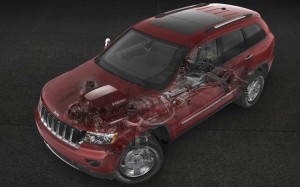The story of the poor results from the Moose/Elk test on Jeep Cherokee in Sweden had the internet and OEMs up in arms. Some people defended Chrysler saying the test was rigged. Some people blamed everything from the test vehicles weight and the surface of the test track. It was even revealed that a German magazine performed the same test with positive results.
People are analyzing tire sizes and asphalt composition, but this is not a mechanical issue. This is an issue with software and the growing role reprogramming or “reflashing” is having for vehicles in the field.
The software that runs the electronic stability control (ESC) system is calibrated by engineers to the vehicle in computer simulations and on test tracks. Most of the time they get it right. But, sometimes problems are not discovered until the vehicle is on the road being driven by the public.
Sometimes the program/calibration for the ESC system needs a little “tweaking” due to changes in the vehicle like a new tire size, changes in the vehicles weight or unforeseen driver behaviors. This is where SAE J2534 reflashing comes into play. If you go to Chrysler’s service information website you can access the updated reflash files so if you had an enhanced scan tool you could recalibrate the software.
The Jeep issued a TSB and a new reflash file in February 2011 for the Cherokee after Consumer Reports reviewed the Cherokee and said that the ESC took too long to intervene in a lane changing test. Consumer Reports later gave the Cherokee higher ratings after the reflash.
This has my thinking: What if the programming and calibrations could be rewritten to take into account the decline of a vehicle? OEMs are already doing this to keep check engine lights out due to aging oxygen sensors on the engines that are within the emissions warranty. With an ESC reflash, the calibrations could be rewritten to take into account changes in friction materials and wear on components like shocks, bushings and springs.
But, most ESC systems will not be recalibrated to take into account most drivers unwillingness to take care of their vehicle and maintaining it at “like new” condition. This is why quality brake and chassis repairs are necessary to keep the ESC within its know calibrations for the coefficient of friction and roll characteristics.
On a side note, most OEMs are very protective of their reflash programs. The growing trend is that the new program does not reside on the hard drive or memory of the reflash tool. Instead, the program is directly burned onto the module from the internet. Most of the OEMs site piracy and intellectual property concerns. Which is valid due to the cost to write the code and test the calibrations is very expensive.
